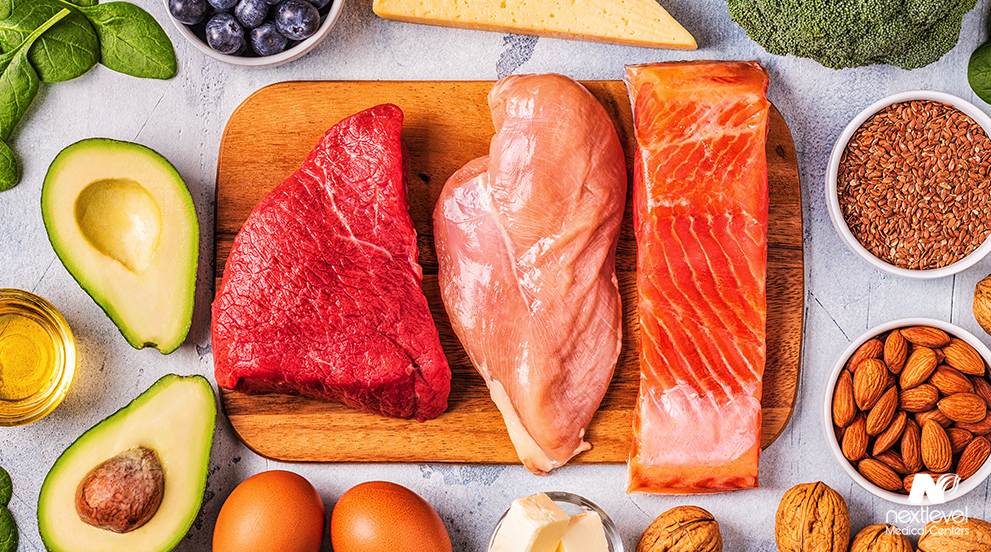

When trying to be the healthiest version of yourself, several key details must be considered. You cannot just wake up one day and declare that you will be healthier than you were before. You must commit to serious lifestyle changes that complement your goal of being healthier. Unfortunately, we live in a time where fads have begun to outnumber the scientifically backed options for improving our health. As a result, we are left navigating an ocean of misinformation and desperately looking for a port. Fortunately, some universal truths still allow us to take the next major step in improving our health with confidence. One of the first things others will tell you to accomplish this goal is to overhaul your dietary habits.
However, changing your diet is not as simple as you think. Not every human body is created equal, and we all process nutrients differently. We have different metabolisms, heights, and body types that impact what types of food are best for us. This means that the best way to improve our diet is to build one tailored to our unique physiology. Creating a custom diet and nutrition plan is no easy feat, meaning information is key. This article will provide that information so you can begin putting your new diet together as soon as possible.
When you are looking to create a specialized diet, you need to account for your unique physiology and biology. You will certainly not share your metabolic rate and other physiological traits with another individual. Fortunately, you can consult with a physician who can provide a little more information about your particular metabolic rate. This duty is usually accomplished by a nutritional expert who can direct guidance on what foods are ideal for your metabolic rate.
Your metabolism is responsible for breaking down calories and converting them into energy. If you want to put together a diet that will keep you energized and promote a healthier physique, you will want to understand your metabolism. Your metabolic rate will depend on your age, sex, height, and other genetic components unique to you. A physician trained in nutrition will be able to measure your metabolic rate and provide a breakdown of what kinds of foods you should eat and how many calories to consume daily.

A slow metabolism can result in greater fat storage, even when you consume foods that are particularly good for you. Therefore, assessing your metabolic rate can make all the difference in your diet.
However, there is more to putting together an ideal diet than your metabolism and calorie count. You will need to construct a diet of foods best suited to your physician’s assessment and the right kind of foods. Fortunately, there is plenty of information about that as well.
Another important part of the ideal diet is selecting foods and beverages that keep your blood’s potential of hydrogen balanced. The potential of hydrogen, also known as pH, affects the acidity of your bloodstream. If your pH falls out of balance, it can lead to serious health issues that vary between men and women. The human body is meant to have a pH level between 7.35 to 7.45 on a scale ranging from 0 to 14. The lower the value is, the more acidic your blood is, whereas the higher the level, the less acidic it is.

If your blood loses or gains acidity to the degree that it falls outside the healthy range, you could develop conditions known as acidosis or alkalosis. These conditions are mutually exclusive from one another as they require different pH levels to manifest:
Fortunately, part of creating your custom diet allows you to add or remove foods known to keep pH levels in balance. You can make sure that acidic foods comprise the smallest part of your diet. Acidic foods should comprise no more than 30% of your overall diet if you want to prevent acidosis. However, you can also introduce alkaline foods, including certain fruits and vegetables, to regulate your pH levels.
Usually, whenever we hear the word “fat,” our minds go straight to a negative connotation. However, plenty of good fats are ideal for creating a balanced diet you can use to improve your health. Many kinds of fats are present in most food, some beneficial to our health while others are harmful. The main categories of fats are:
While trans fats harm our health, monounsaturated and polyunsaturated fats are beneficial and healthy. They are important additions to a healthy diet and should not be overlooked. Fortunately, the sources of these polyunsaturated fats are not difficult to locate as they are present in foods that should serve as staples to the diet you build for yourself. When constructing your diet, you will want to make sure your fat primarily comes from vegetable oils, nuts, seeds, and fish.

All of these foods are highly beneficial sources of monounsaturated and polyunsaturated fats. However, there is also the question of saturated fats. While trans fats are best avoided, saturated fats can be harmful if not consumed cautiously. Saturated fats are commonly found in popular foods such as red meat and dairy products and offer great nutritional value. That said, you should avoid eating these foods in excess as too much can lead to unhealthy results. Instead, foods rich in saturated fats should be occasional treats added to your diet while taking care to prevent them from becoming staples in your daily meals.
For example, focusing on eating fish for most of the week and maybe having a steak on Friday will enable you to maintain a decent saturated fat ratio. However, the physician you saw for the first step will help outline the best ratio for you. While balancing your fat intake is extremely important, there is still a little more you will need to keep in mind when putting your diet together.
One of the most devastating additions to any diet is an excess of sugary snacks. While sugar certainly tastes good, it is what is known as an empty calorie. Sugar has virtually no nutrients beyond calories, meaning it can take up a large number of your daily calorie count without providing significant sustenance you can use to fuel your body. Whenever you consume food, you are trying to absorb essential vitamins and nutrients that generate energy and keep your body well-maintained. Since sugary foods lack virtually all these nutrients, sugar is best avoided in your custom diet.

This is not to say you cannot occasionally enjoy a sugary treat. However, making such treats a regular aspect of your diet can cause your progress not only to stop but reverse. If you want to commit to a diet free of sugars, you will also need to avoid food and drinks with a large quantity of added sugars. This can include soda, ice cream, candy, etc.
While avoiding sugars is important to a successful diet, you will need to know more than just what to avoid. You must know how to balance the nutrients you consume regularly. While all nutrients play a role in fueling and maintaining the human body, some are more important than others.
Not all calories are created equal, as the nutrients that make up those calories can sometimes be lacking in what is necessary for a healthy body. We mentioned before that sugary food and drinks are empty calories because they lack nutrients. However, we now need to consider what nutrients they lack that make them a poor addition to our diets. Every time you look at the nutrition label printed on a food item, you get a breakdown of what makes up the calorie count per serving.
The nutrients printed on the label are usually divided into four categories that help determine the nutrient content simpler. These categories are:
These nutrient labels help you determine how many good nutrients the food offers and how many bad or empty nutrients it will impose. It will also provide a breakdown of the vitamins and minerals present in the product. Usually, it will inform you of the total levels of:
When putting together a custom diet, you will want to focus on foods that are high in good nutrients and low in poor ones.

To start, the fat content of anything you eat should have a higher concentration of saturated fats than trans fats. The carbohydrates you consume should favor fiber over sugar as well. When putting your diet together, you will want to keep these ratios in mind and consider how much of each nutrient per day you should consume.
Keeping these nutrients in mind and balancing your food to meet your daily needs is paramount when creating a customized diet. However, it would help if you always remembered that the food you eat is not everything. In addition, you will need to exercise and live a healthy lifestyle if you want this diet to be of any benefit. Otherwise, you might find yourself struggling to meet your health goals.
You will need to get your feet wet with the 1st step. This means you need to find a professional to provide insight into your body’s metabolic rate.
Creating a customized diet is not a simple task and requires understanding your body. Your metabolic rate and physiology will directly impact the specific intake of nutrients you need, but following these general concepts will take you far. Maintaining a healthy body is hard work and can only be accomplished through dedication to your program. So, once your diet is ready, you will need to follow it religiously if you want to see the desired results. However, you will still need to consult with a professional to ensure the ideal diet is constructed for your needs.

Fortunately, we at Ortho Integrative can help with that. We offer a wide range of health services, including a custom nutrition program you can use to put together the perfect diet. With doctors on staff at all times, we can provide you with all the information you will need to maintain the ideal dietary habits for your body’s health. However, while we can give you the tools, it falls to you to use them properly. So, check out our website and review our program to see if it is what you need to take your health to the Next Level!
Do you have any questions about how you can build a customized diet and nutrition plan? Any concerns you’re potentially having? If so, please do not hesitate to reach out and contact us at any time! We’d love to be able to assist you with your custom plan, and get you started on the path to the new, healthier you!